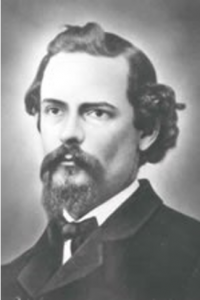
Photo info …
Credit: State of IndianaView Source
(Sept. 3, 1829 – Mar. 6, 1912). Charles A. Ray was born in Indianapolis to early Indianapolis pioneer settler and clerk of the Marion County circuit court James Mitchell and Maria Rebecca Coe Ray. He attended the Marion County Seminary, a public academy for young men his father had founded on September 1, 1834. Charles A. Ray went on to attend Brown University in 1848 but left when his father fell ill a year later. He received an honorary LL.D. from Indiana University and married Avife Laura Amelia Mills in 1849. Ray returned to his legal studies at Harvard University from 1851 to 1852.
After receiving his law degree, Ray formed a partnership with former judge James Morrison. Ray remained in this partnership until 1861. That year governor appointed him to replace John Coburn as judge of Indiana’s 12th Common Pleas District. Morton had commissioned Coburn to serve in the with the rank of colonel. Ray was elected to the judgeship for a full four-year term the following year.
Ray and three other Republican judges (Jehu Elliott, James S. Frazer, and Robert Gregory) were elected to the Indiana Supreme Court in 1864. This historically significant election marked the first instance when Republican candidates succeeded all four Democratic incumbents. The Republican judges became known as the “Lincoln Four.”
The most consequential case the Lincoln Four heard was Smith v. Moody (1866). Ray and the other three judges unanimously struck down Article 13 of the Indiana Constitution that barred African Americans and multiracial individuals from settling in Indiana or entering contracts. The judges argued that Article 13 had contributed to the restricted education, employment, and social progress of African Americans already in Indiana for decades prior to its repeal.
In 1871, Ray was renominated to his judgeship at the state Republican convention, but Samuel Hamilton Buskirk, a lawyer and politician from New Albany, Indiana, defeated him in the election.
After this defeat, Ray spent several months traveling throughout Europe on legal business in 1872. He moved to Washington, D.C., to practice law with Judge Thomas Welles Bartley, former Ohio governor, in 1874. Sometime in the 1870s, Ray moved to California. He practiced law there for a short period before returning to Indianapolis. Starting in 1881, Ray worked in the legal department of the U.S. Postal Service under Postmaster General Thomas L. James. He resigned from the position after two years, choosing to return to legal practice in Indianapolis.
Along with writing articles for numerous legal reviews and journals, he served as associate editor of Western Reporter, a Rochester, New York, legal publication.

Help improve this entry
Contribute information, offer corrections, suggest images.
You can also recommend new entries related to this topic.

